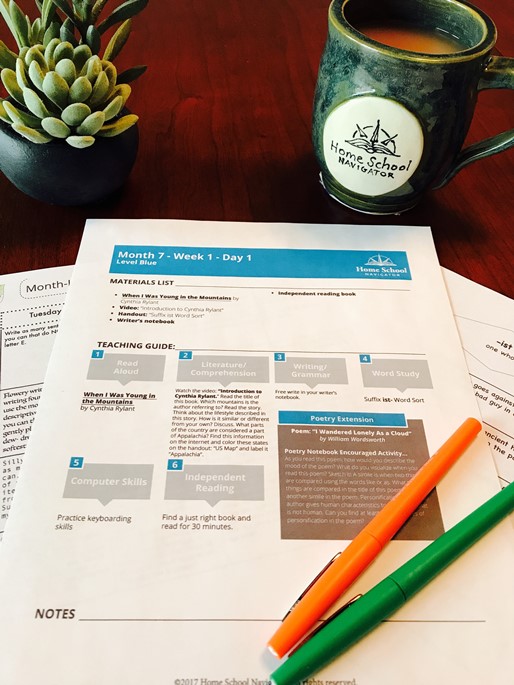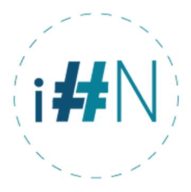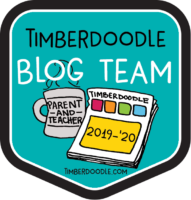
(This review is for a preschool through elementary level Language Arts curriculum. We did not come across any religious content so I believe this is a great option for secular homeschoolers.)
During April four of my kids tried out Home School Navigator a comprehensive language arts curriculum. Two of my kids were able to use Interactive Notebooks as part of their lessons for the month. The Interactive Notebooks can be purchased separately from the rest of the curriculum, but are also included in the larger curriculum.

This review is going to focus on the interactive notebooks, but I will also be addressing my younger boys and the rest of the program at the end of the review. They were not on a level that had interactive notebooks yet. The interactive notebooks start in level green, which is approximately equivalent to a third-grade reading level.
The interactive notebooks on their own earned a 5-star rating from both my girls who used them. (The 4-star in the graphic is covering the whole program.)
My fourth grader did level green (which is 3rd grade), as she is excited about Native American history and the book for the interactive notebooks on the green level was Akhoya and the Talking Leaves. I wanted to let he read a book she would feel confident with, she tried a few pages of The Invention of Hugo Cabret which is the book used for the next level up, which is Blue. (It is a rainbow themed leveling system, but you can read about that on their website.)
For the interactive notebooks, you do need to purchase the book itself separately or get it from the library. For this book, I just bought a digital version because I am super lazy and did not want to go the store or the library. If you have not used interactive notebooks before, they are super fun. They are similar to the concept of lapbooks but instead of folding file folders, you just grab a simple spiral-bound notebook and start gluing, using several pages depending on the scope of the notebook. My fourth grader really enjoyed this book study. It included the following concepts; vocabulary, inference, character, plot, simile, personification, prediction, and has questions asking the child to think about what choices they would have made if they were in a similar situation.
The program suggested writing with charcoal on bark, since that is the method the girl in the book used to write. So I sent my daughter out to the firepit for charcoal and she found some nice chuncky bark to use.
My sixth grader did the book study for Holes, which she had just a few weeks earlier read on her own (outside of assigned reading). She thinks interactive notebooks is a complicated name and so named her notebook with what she thought a more fitting title.
She also enjoyed the interactive notebook. This notebook was from the highest level of the program, which is Indigo and is about 5th-grade level. The work was a little easy for her, but still engaging. I think the month acted as some solid review for her. It may be quite suitable for a 6th grader at the beginning of the year, especially if they are not strong in language arts. The Interactive Notebook at this level covered the following areas; palindromes, vocabulary, description, flashback, character traits, Pig Latin, foreshadowing, inference, prediction, personification, and lots of good questions that ask your child to think about certain aspects of the story and form an opinion.
I just want to mention there are a variety of interactive notebooks for different levels available and you may want to check them out as a light addition to a summer reading book, especially if you need to strengthen the skills covered over the summer.
My younger boys do language arts together, partly because that is how they were made, the younger one picking up reading more easily than the older one due to some eye function issues, and partly because when they are young, putting them together helps keep mom on a schedule of sanity. (Which I think is MOST important!) They are ages 7 and 8, both will have birthdays over the summer. I say they are 2nd and 3rd graders, but for this program, the 2nd-grade level, which is yellow, seemed the most appropriate at the time we started. (I think by end of summer they will be ready for green.) This is a great program whether or not your kids are advanced readers because the literature chosen is rich. For placing kids I just look over some of the writing assignments, because this is always the place in a curriculum that it is least likely my kids will be able to do. So I find the writing assignments that will not overwhelm them and then look at the literature. As long as the literature does not seem too babyish I stick with that level. At this age, numbers don’t matter much, and that is why Home School Navigator chose to use colors instead. I encourage you to find the best fit for your kids and not worry if that means they are ahead or behind.
You go into the month, week, and then the day you are working in for Home School Navigator and then you find a list of subjects. (One thing I wish is that I could view all assignments at the same time, you have to click on each subject to open a drop-down type menu with the assignments and this can only be open for one subject at a time.)
Every day, every level, starts with a read-aloud. One of the great things for larger families is the teachers who created Home School Navigator are creating videos for every read-aloud. So if mom doesn’t have time to do all the read-alouds each child can still hear engaging stories appropriate for their level. This is one of my favorite aspects of the program, of course, I still read aloud also, but it is just a sum total of more exposure to rich vocabulary and stories. You can print off a list of the books needed for the month and head to the library.
The next section is Literature/Comprehension, this is often related to the read-aloud, but more instructional. For example, the read aloud might be a fairy tale, and in this section, they will learn the elements of a fairy tale. What makes a fairy tale a fairy tale? Some days you will find a video here, sometimes a worksheet, other times just an assignment. One the day in the yellow level my boys had to draw a map of Little Red Riding Hood’s journey. They immediately started complaining “Oh, do we have to?” (Like it was some sort of torture exercise.) I was like “Yeah, dudes, of course, you do.” Then they asked we what size of paper they “had” to use. That’s when the real magic happened and I opened up their world by saying “Any size you like.” They immediately found the largest paper possible and were busy for a full 30 quiet (what!!!) minutes. Below you will find their gigantic artwork which now resides on their bedroom wall.
The writing/grammar section is next and will prompt your student to free write in their notebooks most days, for 20 minutes. I love the idea behind this but thought it a little strange that all the levels were using the 20 minute time span. That amount of time was fine for my 4th and 6th grader, but definitely too much for my 2nd and 3rd, so I only had them free write 5 minutes. This is also where you will find grammar lessons, activities, and worksheets. Sometimes there is a larger multi-day writing assignment found here.
Handwriting for the younger grades consists of word wall practice. The yellow level gets 5 words each Monday, and then there is handwriting practice for each day and a test on Friday. There is a cursive version of the words available. I have mixed feeling about this section because it appears to also be meant as the spelling section and writing a word once a day for four days is not even close to enough practice. I do wish there were a lot more activities and suggestions in this section for parents to use to help the students get to where they can write the words by Friday.
The phonics/word study/vocabulary section is different depending on the level, for the Indigo level the focus is on word roots. My student, for example, learned the roots astro and bio, and 9 words which contain the root. This is a fun and well-organized part of the site and I did feel they gave the student enough practice and the right kind of practice. There is a vocab test on Friday’s and my student was able to get 9 words correct most Fridays. For younger levels, this section is more focused on phonics with activities like word sorts.
Independent reading encourages your child to read on their own for 30 minutes a day. I did not set a timer, because my little’s will fatigue before 30 minutes so I just let them read for however long they liked. This is also the section where the literature books with the Interactive Notebooks are assigned. Once your child starts a book they will find the chapters to read and the printables to use for each day in this section.
The last two sections are understanding reading skills and strategy and poetry extension. In addition, on level Indigo my student was prompted to spend time typing each day. The poetry extension is optional and seemed to be the same at some levels. It was too hard for my younger boys to pick up, but the assignment was the same on the higher levels, so I personally would just wait until they are on blue or indigo before adding in the poetry extension. You will have to find the poems used yourself due to copyright laws.
So, in summary, you can see this is a very comprehensive Language Arts program covering all skill areas. It is also literature rich and the activities are relevant and engaging.
The cons I experienced using this program were ambiguous directions and broken links. To be fair there were website changes going on at the beginning of my review period and the missing link problem did clear up after the first couple of weeks. The frustration was compounded by the fact that I could not find any contact information on the website. If I buy an online curriculum product I expect communication and support to be easy and readily available. I could have contacted them by email as a reviewer, but who wants to dig through their inbox to find contact info on a product they purchased months ago? I would love to see more clarity given in some instructions. For example, one assignment under Independent Reading was “Discuss the questions answered yesterday.” Which questions? Do I have to navigate back to yesterday to see which questions my child is supposed to discuss with me? I want all relevant information in front of me. If we are discussing questions, I want them listed, even if they were already answered in written form yesterday. Another assignment to retell a story failed to mention which story.
There is also some awkwardness in the way they schedule make-up day. Every two weeks the program schedules two make-up days. This means instead of new assignments the days can be used to get back on schedule if you had a field trip or sick days in the previous two weeks. I love the idea of built-in makeup days, but putting them together did not make sense. On the yellow level, my kids got word wall words on a Monday and were then tested on Wednesday because Thursday and Friday were set aside as make-up days. Also, what do you do if you don’t need a make-up day? Honestly, I do not need makeup days that frequently and would have preferred if there were some optional enrichment activities for those days. I think this part could be improved.
In conclusion, this curriculum is really a step up from many others as far as coordination and integration of various Language Arts subjects. I love the concept, and my kids and I both loved the literature used. I believe as they continue to develop the program it will move from good to excellent. I plan to continue to use this with my three youngest next year.
Check out other reviews, including different levels and ages than I used on the Homeschool Review Crew Blog.



